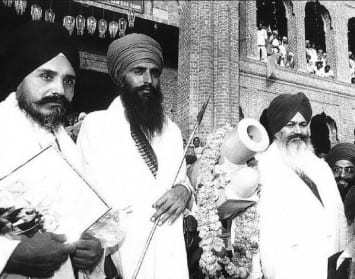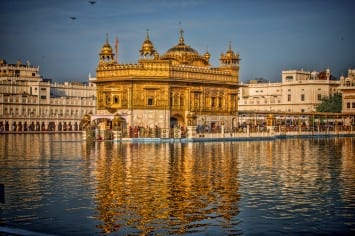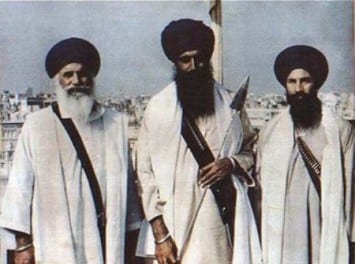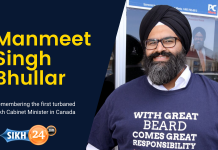Nelson Mandela’s, Truth and Reconciliation Commission is a sensible and a humane approach to the tragic Sikh genocide 0f 1984, but truth must precede reconciliation, and some accountability and recompense must be there to allow forgiveness.
On June 2, 1984 the Punjab governor Pande, a former Indian Civil Service (ICS) officer, summoned the Chief Secretary K.D. Vasudeva, Home Secretary A.S. Pooni, Inspector General Police P.S. Bhinder and Inspector General Intelligence H.S. Randhawa at about 6 p.m. to the Governor’s house for a meeting. Punjab situation was discussed and it was unanimously agreed that Army should not be used to attack the Golden Temple. The Governor agreed, and in their presence, got through to P.C. Alexander, in-charge Prime Minister’s office on the hot-line and informed him that at the moment he was holding a meeting with the senior Punjab officers. They apprehended that the Army may be sent into the Golden Temple. They were against such a step being taken and that he endorsed their view. P.C. Alexander rejected this advice and instructed the Governor to take a letter from the Home Secretary requesting Army intervention in the State
This raises serious questions of constitutional law:
(i) Was the induction of the Army, at the instance of one pressured officer valid and legal?
(ii) Had the Prime Minister’s Office constitutional authority to order directly a State Governor to call in the Army?
Gurdev Singh was the Deputy Commissioner of Amritsar from July 1983 to June 1984. General Brar described him as, “a known supporter of Bhindranwale” but when Gurdev Singh speaks for himself, one gets a different impression. Ram Narain quotes him at length in his book.



He told Narain, “I had told the government at Chandigarh that if they wanted to arrest Bhindranwale there would be no major difficulty. My information said that the terrorists inside the Darbar Sahib (Golden Temple) did not have more than 200-300 guns. Their guns were not even sophisticated. The Army later complained about the inadequate intelligence. I do not know what intelligence they had used. There were half a dozen or more agencies working independently and often at cross purposes. I had confidence in my Crime Investigation Department (CID). Given clear instructions, I would have organized an operation to arrest Bhindranwale. However, the Chief Minister Darbara Singh, Governor B.D. Pandey and Punjab’s Chief Secretary K.D. Vasudeva made it clear that the initiative to take action against Bhindranwale had to come from Chandigarh. Chandigarh was taking its orders from Delhi.”



He adds, “We had been talking about the need to use force since DIG Atwal’s murder in April 1983. I was against the proposal to call the military. My reason was simple, the involvement of the local police was crucial for the success of the Darbar Sahib (Golden Temple) raid. There are myriad approaches to the Temple from the old city. The army and other paramilitary forces, with their ignorance of topography, prevent the terrorists from moving in and out of the Temple complex. I had also told them that the Sikhs of Punjab would resent an Army action much more than a police action. It was possible to tell them that the police action had become necessary because scoundrels and criminals had taken over the Darbar Sahib. However old memories of alien aggression against the Sikh Vatican would inevitably revive if we sent in the military. When I raised this point, they told me ‘Look Gurdev, there is no such plan.’ I must have been repeating my position to the Governor very often. I became cautious when Director General of Police Bhinder and my SSP Ajay Pal Singh Mann advised me that it was not wise that I repeat my position so often and that by over-repetition, the point might be misunderstood.”
During and right after operation Bluestar, Punjab officials made three main complaints to the Army during Operation Bluestar:
1. Some bodies were found, both inside and outside the temple complex, with hands tied behind their back.
2. Six cases of rape in houses adjoining the temple had been brought to their notice (the Army would not allow medical examination of the women, therefore no case was registered).
3. Soldiers had looted temple treasures. (Some of these stolen goods were actually recovered by the Army after this protest was lodged).
The photograph of the body of General Shabeg Singh is much clearer than that of Bhindranwale, a sheet partially covers his naked body, his feet are tied with a heavy rope and from the position of the body and clearly visible trail on the earth behind it, it is clear that it has not been carried, but dragged. Broad red welts on the arms indicate that the arms had been bound with resultant surrounding tissue necrosis. This is interesting because as a general rule, dead men do not put up such resistance as to make binding their arms necessary. Perhaps the end was not as neat as General Brar, or Kanwar Sandhu, the Tribune India executive editor would like us to believe.
The army wanted to cremate the bodies at the first opportunity to prevent any possibility of their being discovered. There is no more potent cause of a riot than a dead body, and so dispensed with the formality of post-mortems. If this was so, the reports which were eventually seen, and photocopied, must have been convenient after-thoughts.
“Published post-mortem reports” of Sant Bhindranwale and Major General Shabeg Singh are flawed:
(1) The time mentioned in the reports is clearly wrong.
(2) The reports admit that both men died of firearm injuries, but makes no mention of the flame and soot effect.
(3) The reports do not mention the type of bullets that pierced their bodies.
(4) The reports make no mention of the bullets, or other marks on the clothes of the men.”
The first photographs had shown their bodies naked. Nobody could have asked them to remove their clothes unless they were in army custody. Surya correspondent R.K. Bajaj confirmed that he had, “personally seen a photograph of Sant Jarnail Singh Bhindranwale in army custody… he was obviously wounded. Amrik Singh was at his side but barely able to stand. There was an army commando pointing a gun at him from the front, with another one at the back.”



In his book Uncivil Wars, Ved Marwah improves on the late prime minister Rajiv Gandhi’s figure of losing* 700 soldiers (CNN) when he writes: “but 35 per cent casualties in a division-level operation cannot be called a well-planned and well-executed operation.” (*A division is comprised of 16,000 troops).
Interestingly, Ved Marwah cites the government’s White Paper as the source of his figures: “4712 persons were killed, and 10,000 arrested during this operation.” Are you puzzled? Somewhere you have read a figure of “493 civilians plus 83 security personnel killed” when also citing the government’s White Paper. The White Paper that all have quoted from is available in libraries, and anyone can go and see the figures for himself. And yet, Ved Marwah is not a man to simply make up figures out of his head. Are there two White Papers, one for the general public, and one for privileged circulation that one could only review in Lok Sabha speaker’s Chamber? Coming from a one-time Special Secretary Home, Government of India, this question is especially interesting.
Let the present government of India (failing which, the government of Punjab) order an impartial and comprehensive inquiry into Operation Bluestar. On the strength of the evidence available, the Supreme Court should be able to take suo moto (acting at/ on it’s own initiative) notice of such a large number of killings. The present government has a moral obligation to the nation to establish the truth. Such an unequivocal commitment to the cause of justice would go a long way toward calming vengeful spirits, and making sure that another round of violence does not occur so that invasion of Punjab, and the genocide of the Sikhs is not repeated again.
Opening Address by President Nelson Mandela in the Special Debate on the Report of the Truth and Reconciliation Commission
http://www.sahistory.org.za/article/opening-address-president-nelson-mandela-special-debate-report-truth-and-reconciliation-comm
(Edited for readability)




